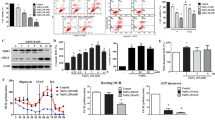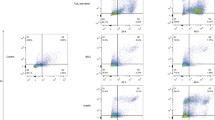Abstract
Endoplasmic reticulum (ER) stress-mediated apoptosis is a well-known factor in the pathogenesis of age-related macular degeneration (AMD). ER stress leads to accumulation of misfolded proteins, which in turn activates unfolded protein response (UPR) of the cell for its survival. The prolonged UPR of ER stress promotes cell death; however, the transition between adaptation and ER stress-induced apoptosis has not been clearly understood. Hence, the present study investigates the regulatory effect of (–)-epigallocatechin gallate (EGCG) on ER stress-induced by hydrogen peroxide (H2O2) and disturbance of calcium homeostasis by thapsigargin (TG) in mouse retinal pigment epithelial (MRPE) cells. The oxidant molecules influenced MRPE cells showed an increased level of intracellular calcium [Ca2+]i in ER and transferred to mitochondria through ER-mitochondrial tether site then increased ROS production. EGCG restores [Ca2+]i homeostasis by decreasing ROS production through inhibition of prohibitin1 which regulate ER-mitochondrial tether site and inhibit apoptosis. Effect of EGCG on ER stress-mediated apoptosis was elucidated by exploring the UPR signalling pathways. EGCG downregulated GRP78, CHOP, PERK, ERO1α, IRE1α, cleaved PARP, cleaved caspase 3, caspase 12 and upregulated expression of calnexinin MRPE cells. In addition to this, inhibition of apoptosis by EGCG was also confirmed with expression of proteins Akt, PTEN and GSK3β. MRPE cells with EGCG upregulates phosphorylation of Akt at ser473 and phospho ser380 of PTEN, but phosphorylation at ser9 of GSK3β was inhibited. Further, constitutively active (myristoylated) CA-Akt transfected in MRPE cells had an increased Akt activity in EGCG influenced cells. These findings strongly suggest that antioxidant molecules inhibit cell death through the proper balancing of [Ca2+]i and ROS production in order to maintain UPR of ER in MRPE cells. Thus, modulation of UPR signalling may provide a potential target for the therapeutic approaches of AMD.








Similar content being viewed by others
References
Lim LS, Mitchell P, Seddon JM, Holz FG, Wong TY (2012) Age-related macular degeneration. The Lancet 379:1728–1738
Swaroop A, Chew EY, Rickman CB, Abecasis GR (2009) Unraveling a multifactorial late-onset disease: from genetic susceptibility to disease mechanisms for age-related macular degeneration. Annu Rev Genomics Hum Genet 10:19–43
Ambati J, Atkinson JP, Gelfand BD (2013) Immunology of age-related macular degeneration. Natrev Immunol 13:438–451
Fritsche LG, Fariss RN, Stambolian D, Abecasis GR, Curcio CA, Swaroop A (2014) Age-related macular degeneration: genetics and biology coming together. Annu Rev Genomics Hum Genet 15:151–171
Hogg RE, Chakravarthy U (2006) Visual function and dysfunction in early and late age-related maculopathy. Prog Retin Eye Res 25:249–276
Zarbin MA, Rosenfeld PJ (2010) Pathway-based therapies for age-related macular degeneration: an integrated survey of emerging treatment alternatives. Retina 30:1350–1367
Whitcup SM, Sodhi A, Atkinson JP, Holers VM, Sinha D, Rohrer B, Dick AD (2013) The role of the immune response in age-related macular degeneration. Int J Inflam 2013:348092
Sunness JS (1999) The natural history of geographic atrophy, the advanced atrophic form of age-related macular degeneration. Mol Vis 5:25
Strauss O (2005) The retinal pigment epithelium in visual function. Physiol Rev 85:845–881
Causin P, Guidoboni G, Malgaroli F, Sacco R, Harris A (2015) Blood flow mechanics and oxygen transport and delivery in the retinal microcirculation: multiscale mathematical modeling and numerical simulation. Biomechanics Modeling Mechanobiol 15:525–542
Saadat KA, Murakami Y, Tan X, Nomura Y, Yasukawa T, Okada E, Ikeda Y, Yanagi Y (2014) Inhibition of autophagy induces retinal pigment epithelial cell damage by the lipofuscinfluorophore A2E. FEBS Open Bio 15:1007–1014
Sur A, Kesaraju S, Prentice H, Ayyanathan K, Baronas-Lowell D, Zhu D, Hinton DR, Blanks J, Weissbach H (2014) Pharmacological protection of retinal pigmented epithelial cells by sulindac involves PPAR-α. Proc Natl Acad Sci USA 111:16754–16759
He Y, Leung KW, Ren Y, Pei J, Ge J, Tombran-Tink J (2014) PEDF improves mitochondrial function in RPE cells during oxidative stress. Invest Ophthalmol Vis Sci 55:6742–6755
Abrahan CE, Miranda GE, Agnolazza DL, Politi LE, Rotstein NP (2010) Synthesis of sphingosine is essential for oxidative stress-induced apoptosis of photoreceptors. Invest Ophthalmol Vis Sci 51: 1171–1180
Zarbin MA (2004) Current concepts in the pathogenesis of age-related macular degeneration. Arch Ophthalmol 122:598–614
He S, Yaung J, Kim YH, Barron E, Ryan SJ, Hinton DR (2008) Endoplasmic reticulum stress induced by oxidative stress in retinal pigment epithelial cells. Graefes Arch Clin Exp Ophthalmol 246:677–683
Schroder M, Kaufman RJ (2005) The mammalian unfolded protein response. Annu Rev Biochem 74:739–789
Brewster JL, Linseman DA, Bouchard RJ, Loucks FA, Precht TA, Esch EA, Heidenreich KA (2006) Endoplasmic reticulum stress and trophic factor withdrawal activate distinct signalling cascades that induce glycogen synthase kinase-3β and a caspase-9-dependent apoptosis in cerebellar granule neurons. Mol Cell Neurosci 32:242–253
Szegezdi E, Logue SE, Gorman AM, Samali A (2006) Mediators of endoplasmic reticulum stress-induced apoptosis. EMBO Rep 7:880–885
Logue SE, Cleary P, Saveljeva S, Samali A (2013) New directions in ER stress-induced cell death. Apoptosis 18:537–546
Zhang SX, Sanders E, Fliesler SJ, Wang JJ (2014) Endoplasmic reticulum stress and the unfolded protein responses in retinal degeneration. Exp Eye Res 125:30–40
Nagle DG, Ferreira D, Zhou YD (2006) Epigallocatechin-3-gallate (EGCG): chemical and biomedical perspectives. Phytochemistry 67:1849–1855
Lee YW, Lee WH, Kim PH (2010) Oxidative mechanisms of IL-4-induced IL-6 expression in vascularendothelium. Cytokine 49:73–79
Chan CM, Huang JH, Lin HH, Chiang HS, Chen BH, Hong JY, Hung CF (2008) Protective effects of (–)-epigallocatechin gallate on UVA-induced damage in ARPE19 cells. Mol Vis 14:2528
Yang SW, Lee BR, Koh JW (2007) Protective effects of epigallocatechin gallate after UV irradiation in cultured human retinal pigment epithelial cells. Korean J Ophthalmol 21:232–237
Chen C, Cano M, Wang JJ, Li J, Huang C, Yu Q, Herbert TP, Handa JT, Zhang SX (2014) Role of unfolded protein response dysregulation in oxidative injury of retinal pigment epithelial cells. Antioxid Redox Signal 20:2091–2106
Juel HB, Faber C, Svendsen SG, Vallejo AN, Nissen MH (2013). Inflammatory cytokines protect retinal pigment epithelial cells from oxidative stress-induced death. PLoS One 8:e64619
Karthikeyan B, Arun A, Harini L, Sundar K, Kathiresan T (2016) Role of ZnS Nanoparticles on endoplasmic reticulum stress-mediated Apoptosis in retinal pigment epithelial cells. Biol Trace Elem Res 170:390–400
Olchawa MM, Herrnreiter AM, Pilat AK, Skumatz CM, Niziolek-Kierecka M, Burke JM, Sarna TJ (2015) Zeaxanthin and α-tocopherol reduce the inhibitory effects of photodynamic stress on phagocytosis by ARPE-19 cells. Free Radic Biol Med 89:873–882
Hanus J, Kolkin A, Chimienti J, Botsay S, Wang S (2015) 4-Acetoxyphenol prevents RPE oxidative stress-induced necrosis by functioning as an NRF2 stabilizer. Invest Ophthalmol Vis Sci 56:5048–5059
Hetz C (2012) The unfolded protein response: controlling cell fate decisions under ER stress and beyond. Nat Rev Mol Cell Biol 13:89–102
Karthikeyan B, Kalishwaralal K, Sheikpranbabu S, Deepak V, Haribalaganesh R, Gurunathan S (2010) Gold nanoparticles down regulate VEGF-and IL-1β-induced cell proliferation through Src kinase in Retinal pigment epithelial cells. Exp Eye Res 91:769–778
Lee JH, Moon JH, Kim SW, Jeong JK, Nazim UM, Lee YJ, Seol JW, Park SY (2015) EGCG-mediated autophagy flux has a neuroprotection effect via a class III histone deacetylase in primary neuron cells. Oncotarget 6:9701–9717
Mandel SA, Amit T, Kalfon L, Reznichenko L, Weinreb O, Youdim MB (2008) Cell signaling pathways and iron chelation in the neurorestorative activity of green tea polyphenols: special reference to epigallocatechin gallate (EGCG). J Alzheimers Dis 15:211–222
Cheng CWJ, Huang HC, Chen WJ, Huang CN, Peng CH, Lin CL (2015) Epigallocatechin gallate attenuates amyloid β-induced inflammation and neurotoxicity in EOC 13.31 microglia. Eur J Pharmacol 770:16–24
Simo R, Villarroel M, Corraliza L, Hernandez C, Garcia-Ramirez M (2010) The retinal pigment epithelium: something more than a constituent of the blood-retinal barrier–implications for the pathogenesis of diabetic retinopathy. J Biomed Biotechnol 2010:190724
Brantley MA, Osborn MP, Sanders BJ, Rezaei KA, Lu P, Li C, Milne GL, Cai J, Sternberg P (2012) Plasma biomarkers of oxidative stress and genetic variants in age-related macular degeneration. Am J Ophthalmol 153:460–467
Yao J, Liu X, Yang Q, Zhuang M, Wang F, Chen X, Hang H, Zhang W, Liu Q (2013) Proteomic analysis of the aqueous humor in patients with wet age-related macular degeneration. Proteomics Clin Appl 7:550–560
Salminen A, Kauppinen A, Hyttinen JM, Toropainen E, Kaarniranta K (2010) Endoplasmic reticulum stress in age-related macular degeneration: trigger for neovascularization. Mol Med 16:535–542
Bae JH, Mun KC, Park WK, Lee SR, Suh SI, Baek WK, Yim MB, Kwon TK, Song D (2002) EGCG attenuates AMPA-induced intracellular calcium increase in hippocampal neurons. Biochem Biophys Res Commun 290:1506–1512
Choi YT, Jung CH, Lee SR, Bae JH, Baek WK, Suh MH, Park JH, Park CW, Suh SI (2001) (–)-Epigallocatechin gallate attenuates β–amyloid induced neurotoxicity in cultured hippocampal neurons. Life Sci 70:603–614
Theiss AL, Sitaraman SV (2011) The role and therapeutic potential of prohibitin in disease. Biochim Biophys Acta 1813:1137–1143
Kathiria AS, Butcher LD, Feagins LA, Souza RF, Boland CR, Theiss AL (2012) Prohibitin 1 modulates mitochondrial stress-related autophagy in human colonic epithelial cells. PLoS One 7:e31231
Libby RT, Gould DB (2010) Endoplasmic reticulum stress as a primary pathogenic mechanism leading to age-related macular degeneration. Adv Exp Med Biol 664:403–409
Brown MK, Naidoo N (2012) The endoplasmic reticulum stress response in aging and age-related diseases. Front Physiol 16:263
Goetz JG, Genty H, St-Pierre P, Dang T, Joshi B, Sauvé R, Vogl W, Nabi IR (2007) Reversible interactions between smooth domains of the endoplasmic reticulum and mitochondria are regulated by physiological cytosolic Ca2+ levels. Cell Sci 120:3553–3564
Huber AL, Lebeau J, Guillaumot P, Pétrilli V, Malek M, Chilloux J, Fauvet F, Payen L, Kfoury A, Renno T, Chevet E, Manié SN (2013) p58IPK-mediated attenuation of the proapoptotic PERK-CHOP pathway allows malignant progression upon low glucose. Mol Cell 49:1049–1059
Khan N, Afaq F, Saleem M, Ahmad N, Mukhtar H (2006) Targeting multiple signaling pathways by green tea polyphenol (–)-epigallocatechin-3-gallate. Cancer res 66:2500–2505
Higdon JV, Frei B (2003) Tea catechins and polyphenols: health effects, metabolism, and antioxidant functions. Crit Rev Food Sci Nutr 43:89–143
Szegezdi E, Fitzgerald U, Samali A (2003) Caspase-12 and ER-stress-mediated apoptosis: the story so far. Ann NY Acad Sci 1010: 186–194
Nakagawa T, Zhu H, Morishima N, Li E, Xu J, Yankner BA, Yuan J (2000) Caspase-12 mediates endoplasmic-reticulum-specific apoptosis and cytotoxicity by amyloid-β. Nature 403:98–103
Karthikeyan B, Harini L, Sundar K, Kathiresan T (2016) Cytotoxic effect of ZnS nanoparticles on primary mouse retinal pigment epithelial cells. Artif Cells Nanomed Biotechnol 44:1764–1773
Hu P, Han Z, Couvillon AD, Exton JH (2004) Critical role of endogenous Akt/IAPs and MEK1/ERK pathways in counteracting endoplasmic reticulum stress-induced cell death. J BiolChem 279:49420–49429
Kim MJ, Kim HI, Chung J, Jeong TS, Park HR (2009) (–)-Epigallocatechin-3-gallate (EGCG) increases the viability of serum-starved A549 cells through its effect on Akt. Am J Chin Med 37:723–734
Acknowledgments
This study was supported in part by a Grant-in-Aid from Department of Science and Technology (SERB) of India (SB/FT/LS-204/2012) to T. K. B. K. is the recipient of senior research fellowship (09/1012 (0005) 2K11—EMR—I) from the Council of Scientific and Industrial Research (CSIR), India.
Author information
Authors and Affiliations
Corresponding author
Ethics declarations
Conflict of interest
The authors declare that there are no conflicts of interest.
Rights and permissions
About this article
Cite this article
Karthikeyan, B., Harini, L., Krishnakumar, V. et al. Insights on the involvement of (–)-epigallocatechin gallate in ER stress-mediated apoptosis in age-related macular degeneration. Apoptosis 22, 72–85 (2017). https://doi.org/10.1007/s10495-016-1318-2
Published:
Issue Date:
DOI: https://doi.org/10.1007/s10495-016-1318-2




